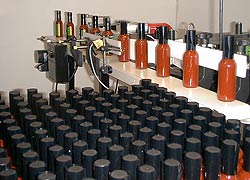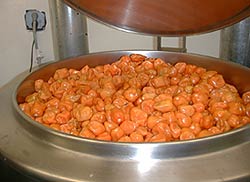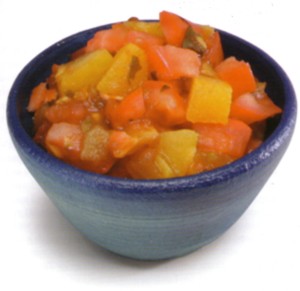By Dave DeWitt and Chuck Evans
Recipes:
Homemade Tabasco®-Style Sauce
Keeping “Pace®” with Picante Sauces
“Hotter Than Heinz®” Ketchup
Caribbean Sun-of-a Beach Hot Pepper Sauce
Chuck’s Chipotle Sauce
Transplanted Sriracha Sauce
Editor’s Note: One question that is asked over and over again in email to us is: “How do I make hot sauce?” Well, Chuck Evans and I wrote an entire book on this subject back in 1996, The Hot Sauce Bible. Unfortunately, that book is currently out of print, but can sometimes be found used at amazon.com. But, of course, we still have all the files and recipes from the book. So here is a selection on commercial manufacturing, along with some recipes for attempting to duplicate some of the classic hot sauces that are most popular today.
|
|
Commercial Hot Sauce Manufacturing:Labeling the bottled product.
|
Commercial Hot Sauce Manufacturing
There is no textbook for making hot pepper sauces commercially, which is one of the reasons for the wide variety of sauces available. Manufacturers learn by word of mouth, and during their experimentation, fashion sauces from virtually every cultivated chile pepper using many different production methods.
“There are wide variations in hot sauce production,” wrote the editors of Wine & Food Companion in their hot pepper sauce study. “Some manufacturers salt chile peppers, then mash them; others just toss whole chiles in brine. Some age the mash in white oak barrels; others say you can’t tell the difference between ageing in oak and aging in plastic. Some brag about ageing for three years; others say a month is enough.”
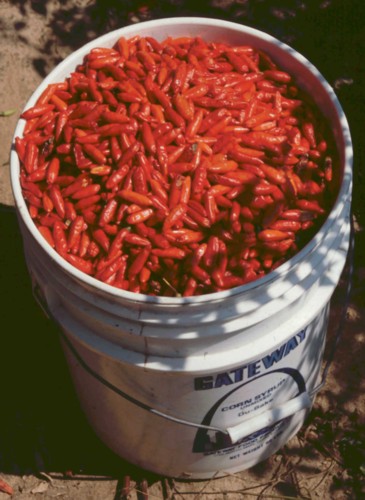 Since Tabasco® sauce is the longest continually produced hot pepper sauce, let’s start with their procedure, which the McIlhenny Company has used for more than 125 years. After harvest, whole tabasco chiles are crushed in a hammer mill; salt is added in the amount of 8 pounds of salt for every 100 pounds of chiles. This mash is placed in Kentucky white oak barrels with salt-sealed wooden lids that have tiny holes which allow the gases of the peppers to escape during fermentation. The wooden tops are secured and placed on the barrels with stainless steel hoops (iron hoops disintegrate in the air of the salt and pepper mash).
Since Tabasco® sauce is the longest continually produced hot pepper sauce, let’s start with their procedure, which the McIlhenny Company has used for more than 125 years. After harvest, whole tabasco chiles are crushed in a hammer mill; salt is added in the amount of 8 pounds of salt for every 100 pounds of chiles. This mash is placed in Kentucky white oak barrels with salt-sealed wooden lids that have tiny holes which allow the gases of the peppers to escape during fermentation. The wooden tops are secured and placed on the barrels with stainless steel hoops (iron hoops disintegrate in the air of the salt and pepper mash).
Each 400-pound barrel is aged for three years, allowing the carbon dioxide to be released for the first two years. After this time, the salt topping hardens and naturally seals the barrel after the fermentation process ceases. The mellowing and aging process is called steeping, permitting the flavors and color to intermingle and mix naturally. The barrels are uncovered and oxidized mash is removed from the top of the barrels. The mash is inspected for aroma, color, and moisture. Upon being accepted under McIlhenny standards, the mash is pumped into large blending vats and mixed with distilled, all-natural white vinegar in the ratio of two-thirds vinegar to one-third mash. (Before being manufactured with commercial equipment, the blending process was referred to as “pounding,” where the pepper mash was pushed manually through a strainer, where the vinegar was added, with a flat-headed “pounder”. This was a very time-consuming process and took a lot of manual labor to do large quantities of sauce.)
For a month, this mixture is stirred for five minutes every hour. Finally, the vinegar-mash solution is strained, filtered, and bottled under the familiar trademarked diamond-shaped white, green, and red label. The strained mash residue is sold to crawfish boil and hot pepper cream manufacturers.
Making Mash
Many hot pepper sauces on the market today are made from mash, and Dave was fortunate enough in 1992 to visit the habanero mash plant of Quetzal Foods in the appropriately named town of Los Chiles, Costa Rica. Stuart Jeffrey and Cody Jordan had set up quite a major growing and packing operation, consisting of several hundred acres of their specially developed ‘Rica Red’ variety of habanero. When Dave arrived at the site, they had twenty-four tons of ‘Rica Red’ mash sitting on their loading dock–with tons of additional mash being produced every day. Stuart and Cody revealed to us the steps in producing habanero mash, the first stage in hot sauce manufacturing.
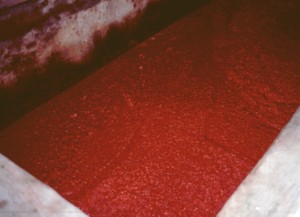
Freshly made mash from Rica Red habaneros
The ‘Rica Red’ habaneros were picked, destemmed, sorted, bagged, and moved to the plant from the field by pickup truck. A flowing water wash cleaned the chiles, which weree further sorted, and then they were treated with an organic grapefruit extract for disinfection. The chiles were moved from the wash by conveyor belt into a revolving cylinder which spin-dried the chiles. From the drier, the chiles moved to the grinder, where they were ground into one-half or one-quarter inch pieces. Salt was added at this stage to fifteen percent of the weight of the chiles. The rough mash was pumped into sealed tanks and fermented for ten to twelve days. The fermented mash was pumped into nylon bags with polyethylene liners which were supported by heavy wooden frames. The package is called a “tote” and weighs 2,200 pounds. The totes were sealed with nylon ties and are transported by truck to Limón, where they were sent in containers to Louisiana. The mash continued to ferment about five percent more during shipping. After further aging in Louisiana, the mash was used by hot sauce manufacturers to add heat to cayenne sauces. At the plant, a pulper removed seeds and skin particles before it was blended. Dilution with water or vinegar reduces the salt concentration to less than ten percent.
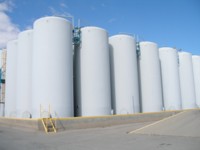 Mash storage tanks at Cervantes Enterprises, Vado, NM
Mash storage tanks at Cervantes Enterprises, Vado, NM
Manufacturing Montezuma® Brand Hot Sauces
Hot sauce manufacturing at Sauces & Salsas, Ltd., producers of the Montezuma® brand is a multi-faceted manufacturing operation. This small specialty sauce manufacturer has created a diverse line of fifteen hot pepper sauces, including America’s number one selling brown hot pepper sauce, Montezuma® Smokey Chipotle®. They also produce eight different salsas, including Veracruz Peanut Salsa, Smokey Chipotle® Salsa, and Salsa Michoacan, as well as their flagship Fiesta Salsa. Other products include Jamaican Jerk Marinade, a finalist in the condiment category at the 1991 International Fancy Food & Confection Show in New York, several Hot Chicken Wing Sauces, BBQ Sauces, Meat Marinades, Pepper Spreads, Taco and Tex-Mex Chili Spice Mixes, and a full line of Tortilla Chips.
Developing this wide assortment of chile sauces and salsas required years of experimentation. Many of the recipes have their roots in older recipes that were used fresh; others were created by the owner of the company, coauthor Chuck Evans. All recipes have been developed and modified to achieve a desired finished product that compliments the taste characteristics of the any of the twenty-four different chiles that Chuck uses in his products.
This diverse line requires several unique processing methods and an unusual array of grinding and cutting equipment to process all of these items in the small, but efficient facility. The chicken wing sauces are created by grinding the pepper mash (one sauce is made from a red jalapeño mash, the other from a red habanero mash) through an emulsifier, which totally turns any seeds and solids to liquid, utilizing all of the chile pulp. The pulp is mixed in a one to one ratio with distilled white vinegar, garlic, and spices, and the mixture is blended by hand with wooden paddles, thoroughly mixing the sauce until it reaches a blended and smooth consistency. The finished sauce will set three to four weeks, and the sauce is stirred intermittently. Both mashes are aged approximately one to one and a half months before further dilution with vinegar. Then the sauce is bottled and labeled.
Sauces & Salsas, Ltd. cooks only two of their fifteen hot pepper sauces and four different processes are used to create them. The hot sauces that originate from a pepper mash are made in the same fashion as the chicken wing sauces mentioned previously. None of these items are cooked. The hot pepper sauces that originate from chopped chiles have one additional step, which is grinding the chiles to a mash prior to emulsifying the mash to a liquid. The remainder of the hot pepper sauces start from dried Mexican chiles. The chiles need to be reconstituted and rehydrated to a plump and juicy state. This is done by placing the dried chiles in plastic pails with the spices, salt, garlic, and vinegar. Either white distilled vinegar or apple cider vinegar is used and sometimes utilizing a blend of the two. The white distilled vinegar is generally used in the hotter pepper sauces as this vinegar adds a bite and sharper edge to the already hot pepper mash. The apple cider vinegar is used for the more delicate pepper sauces, giving it a mellower and more subtle flavor.
The rehydrating chiles usually sit for about two months, allowing the chiles to gain flavor through the spices and vinegar and to gain plumpness by absorbing the vinegar. The entire mixture is then processed in a grinder, making a thick and strong pulp mash. Since the chiles have steeped for a couple months, the peppers are very soft and grind very easily. After this grinding process, the pepper mashes are put through their own additional grinding process, utilizing an emulsifying grinder that takes the pulp, skins, seeds, and all and reduces them to a liquid. This thick mash is then aged for another 3 to 5 months and stored. After vinegar is added to the mash until the desired consistency is achieved, the finished sauce is thoroughly stirred and set aside until ready for bottling.
The two hot pepper sauces requiring cooking are the Spicy Peanut Hot Sauce, which is made the same way as the other pepper sauces, with the addition of bulk chopped peanuts that also steep in vinegar with the chiles during rehydration. After completing the two grinding processes and reaching the finished sauce stage, the sauce is then cooked until reaching a temperature of 185 degrees. This is necessary as the oil in the peanuts will expand in the warmer months and cooking stabilizes the sauce and prevents an overflowing peanut pepper sauce bottle.
The Montezuma® Aztec Hot Pepper Sauce is produced from a very old recipe that dates back to the days of the Spanish conquest in central Mexico. This is the only pepper sauce that is made with pumpkin seeds (pepitas) and sesame seeds. The seeds are toasted in a dry skillet at medium heat until they begin to pop (caused by oil in seeds expanding). The seeds are added to the steeping chiles de arbol, along with a unique spice mixture, garlic, and apple cider vinegar. The process follows the same as noted above, finished by cooking the sauce in order to stabilize the oil from the seeds and bottling the finished sauce.
The bottling process at Sauces and Salsas, Ltd. is basically still a hand-pack operation and intensive manual labor is required to process their product line. The manufacture of the salsas and BBQ sauces requires the mixing of the specific ingredients and hot-filling the jars once the sauces reach the required temperature. Utilizing a single-stroke piston-filling machine, the jars are then capped by hand, protective bands are added in their distinctive solid red color, lid labels adhered by hand, and the product label is manually placed to finish the package.
For home cooks who wish to experiment with making commercial-style sauces at home, we offer the following recipes that approximate famous sauces.
Homemade Tabasco® -Style Sauce
Because the chiles are not aged in oak barrels for three years, this will be only a rough approximation of the famous McIlhenny product. You will have to grow your own tabascos or substitute dried ones that have been rehydrated. Other small, hot, fresh red chiles can also be substituted for the tabascos.
-
1 pound fresh red tabasco chiles, chopped
-
2 cups distilled white vinegar
-
2 teaspoons salt
Combine the chiles and the vinegar in a saucepan and heat. Stir in the salt and simmer for 5 minutes. Remove from the heat, cool, and place in a blender. Puree until smooth and place in a glass jar. Allow to steep for 2 weeks in the refrigerator.
Remove, strain the sauce, and adjust the consistency by adding more vinegar if necessary.
Yield: 2 cups
Heat Scale: Hot
Note: This recipe requires advance preparation.
Keeping “Pace®” with Picante Sauces
Although most commercial salsas and picante sauces are made from similar ingredients, their flavors differ because of spices, cooking techniques, and the proportion of ingredients. Perhaps this home-cooked version outdoes the original–you tell us. It is important to use only Mexican oregano, as Mediterranean oregano will make this taste like a pasta sauce.
-
6 to 8 ripe red tomatoes (about 4 pounds), peeled, seeded, and chopped fine
-
2 onions, chopped
-
3 cloves garlic, minced
-
1 cup cider vinegar
-
2 teaspoons Mexican oregano
-
1 tablespoon tomato paste
-
Salt to taste
-
6 jalapeño chiles, seeds and stems removed, chopped
In a large saucepan or Dutch oven, combine the tomatoes, onions, garlic, vinegar, oregano, and salt. Bring to a boil, reduce the heat and cook for 15 minutes on medium heat to thicken the sauce.
Add the jalapeños and continue cooking for 15 more minutes. Remove from the heat, cool to room temperature, and serve with chips.
Yield: About 4 cups
Heat Scale: Medium
|
|
Not for the faint of heart:
|
“Hotter Than Heinz®” Ketchup
With salsa overtaking ketchup in sales volume in 1992, it made sense that the ketchup makers would fight back. There are several dozen brands of hot and spicy ketchup on the market these days, and more to come.
-
6 pounds ripe tomatoes, chopped
-
1 small purple onion, peeled and chopped
-
2 teaspoons dried Italian parsley
-
1 1/2 cups malt vinegar
-
1/2 cup plus 2 tablespoons packed brown sugar
-
3/4 teaspoon salt
-
Dash of white pepper
-
1/2 teaspoon habanero powder (or more to taste)
-
1 cinnamon stick, halved
-
1/2 whole nutmeg, tapped carefully with a hammer to split
-
1/2 teaspoon mustard seeds
-
1 teaspoon fennel seeds
Place the tomatoes, onion, and parsley in a 4 to 5 quart heavy pot. Bring the ingredients to a boil over high heat, reduce the heat to medium, and cook until the tomatoes are softened, about 20 to 25 minutes.
Press the tomato mixture through a fine sieve, pressing hard on the solids with the back of a broad wooden spoon to release the puree. Return the puree to the pot and discard the solids.
Add the vinegar, sugar, salt, white pepper, and the powdered habanero chile to the puree. Tie the remaining ingredients in several layers of cheesecloth, and add them to the pot. Bring the mixture to a boil over high heat, reduce the heat to medium, and cook 2 to 2 1/2 hours, uncovered. As it cooks, periodically remove the froth that rises and stir down the sides. When the mixture is very thick, remove the tied spices.
Ladle the ketchup into a jar. Allow it to cool, and refrigerate. It keeps indefinitely.
Yield: 2 1/2 cups
Heat Scale: Medium
|
|
Soon to be Hot Sauce:Fresh habanero chiles in a60-gallon industrial
|
Caribbean Sun-of-a Beach Hot Pepper Sauce
If there were a typical eastern Caribbean hot sauce, this might be it. It has hints of Trinidad, Barbados, and even Grenada. To be perfectly authentic, you should buy or grow the red habaneros so popular in that part of the Caribbean, called Congo or bonney peppers.
-
1/2 pound red habanero chiles, seeds and stems removed
-
1 white onion, chopped
-
2 cloves garlic, chopped
-
1/2 cup cider vinegar
-
1/2 cup lime juice (or lemon juice)
-
2 tablespoons water
-
1 medium papaya, boiled until tender, peeled, seeded, and finely chopped
-
1 tomato, finely chopped
-
1 teaspoon thyme
-
1 teaspoon basil
-
1/2 teaspoon ground nutmeg
-
2 tablespoons dry mustard
-
1/2 teaspoon turmeric
Combine the chiles, onion, garlic, papaya, and tomato in a food processor and puree (you may have to do this in batches). Remove to a shallow bowl.
Combine the vinegar, lime juice, and water in a saucepan and heat until it reaches a slight boil, then sprinkle the thyme, basil, nutmeg, mustard, and turmeric. Pour this hot, spiced mixture over the reserved puree and mix thoroughly. It will last up to eight weeks in the refrigerator.
Yield: 3 to 4 cups
Heat Scale: Hot
Chuck’s Chipotle Sauce
This chipotle sauce is a version of coauthor Chuck’s best-selling brown hot sauce, Smokey Chipotle® Hot Sauce, manufactured by Sauces & Salsas, Ltd. under the Montezuma® brand. A tasty way to reconstitute dried chipotle chiles is to place them in a bowl and cover them with cider vinegar. After several days, the chiles will be reconstituted and will be plump.
-
12 dried chipotle chiles, stems removed, reconstituted as above or soaked in hot water for 1 hour
-
1 medium white onion, sliced
-
3 cloves garlic, sliced
-
3 cups water
-
1/4 cup cider vinegar
-
1/4 cup tomato sauce
-
Salt to taste
-
2 cups white distilled vinegar (more or less, depending on the thickness of the sauce you desire)
Combine all the ingredients except the 2 cups of distilled vinegar in a saucepan, cover, and simmer over low heat until the sauce is reduced to about 1 1/2 cups. Puree the mixture in a food processor or a blender until a paste-like, seeded mixture is achieved.
Combine the paste and the vinegar in a bowl and stir well. Strain through a sieve to remove the seeds and discard the solids.
Yield: 3 to 4 cups
Heat Scale: Hot
Transplanted Sriracha Sauce
A table condiment to similar to ketchup–but much more pungent–sriracha sauce is named after a seaside town in Thailand. Increasingly popular, this sauce is found on the tables of Thai and Vietnamese restaurants all over North America. Fresh red chiles are the key to the flavor of this recipe.
-
1 pound fresh red serrano, cayenne, Thai, or chile de arbol chiles, stems removed
-
2 1/2 cups rice vinegar (substitute white distilled vinegar)
-
1/4 cup sugar
-
1 tablespoon salt
Remove the stems from the chiles. Place the chiles and vinegar in a saucepan and heat to boiling. Turn off the heat and add the sugar and salt and stir until dissolved. Place the saucepan contents in a food processor or blender and puree until a smooth thin-paste consistency. Add additional rice vinegar if the mixture is too thick. Allow the mixture to steep for several hours, place in glass containers, and refrigerate. The consistency should be slightly thinner than ketchup.
Optional: Strain the sauce through sieve and discard the solids for a smooth, seedless consistency.
Yield: 3 to 4 cups
Heat Scale: Hot
Photos/Illustrations by Harald Zoschke






